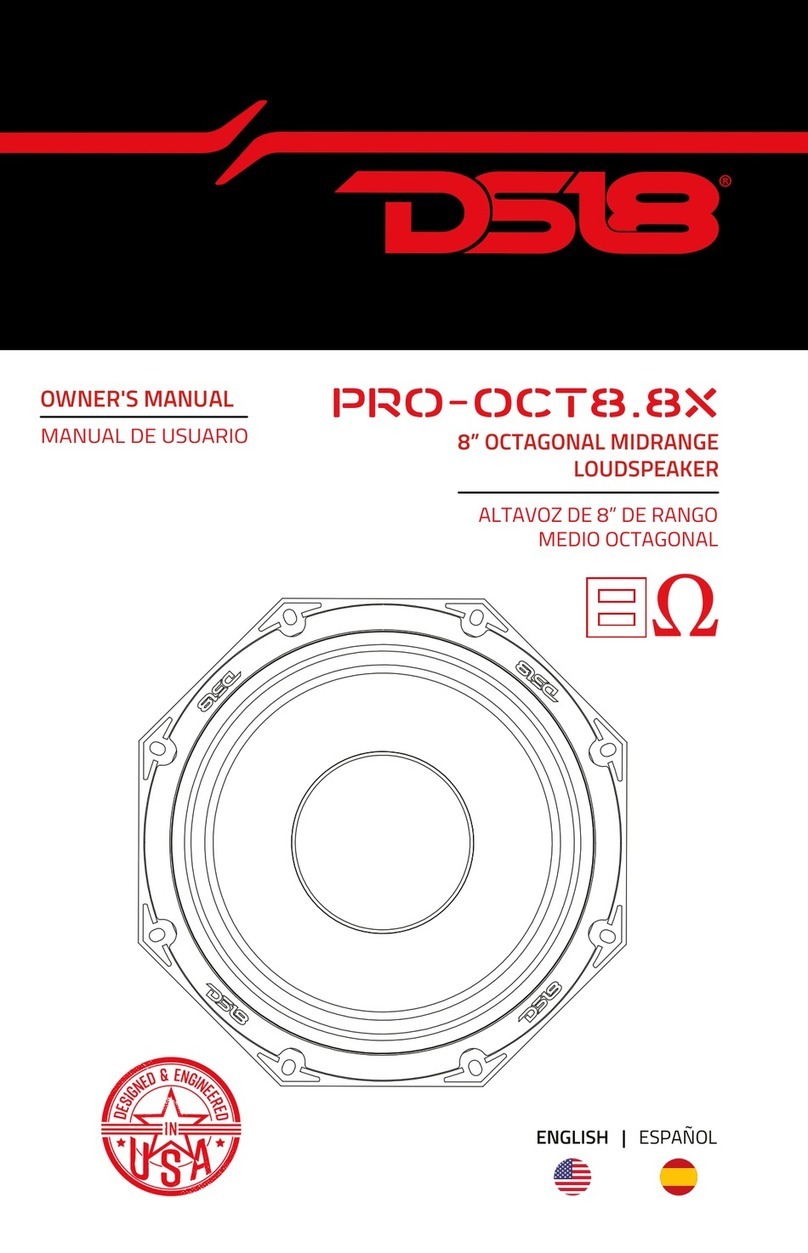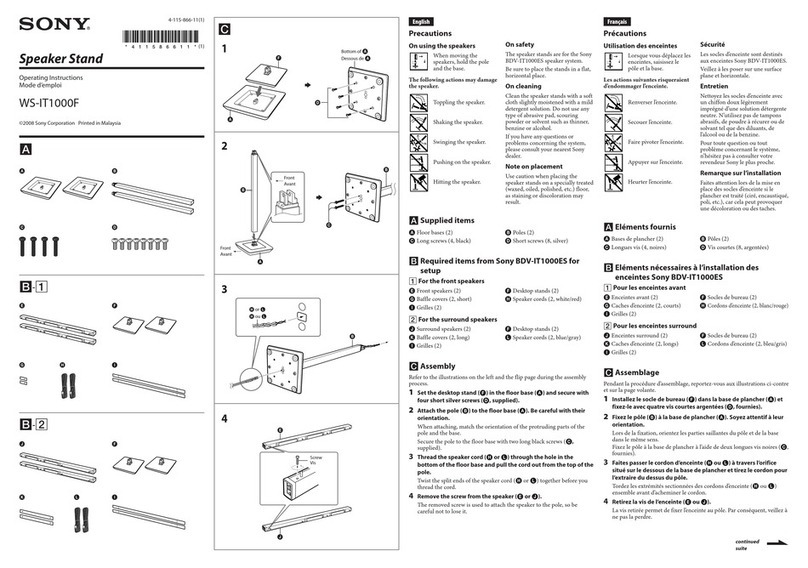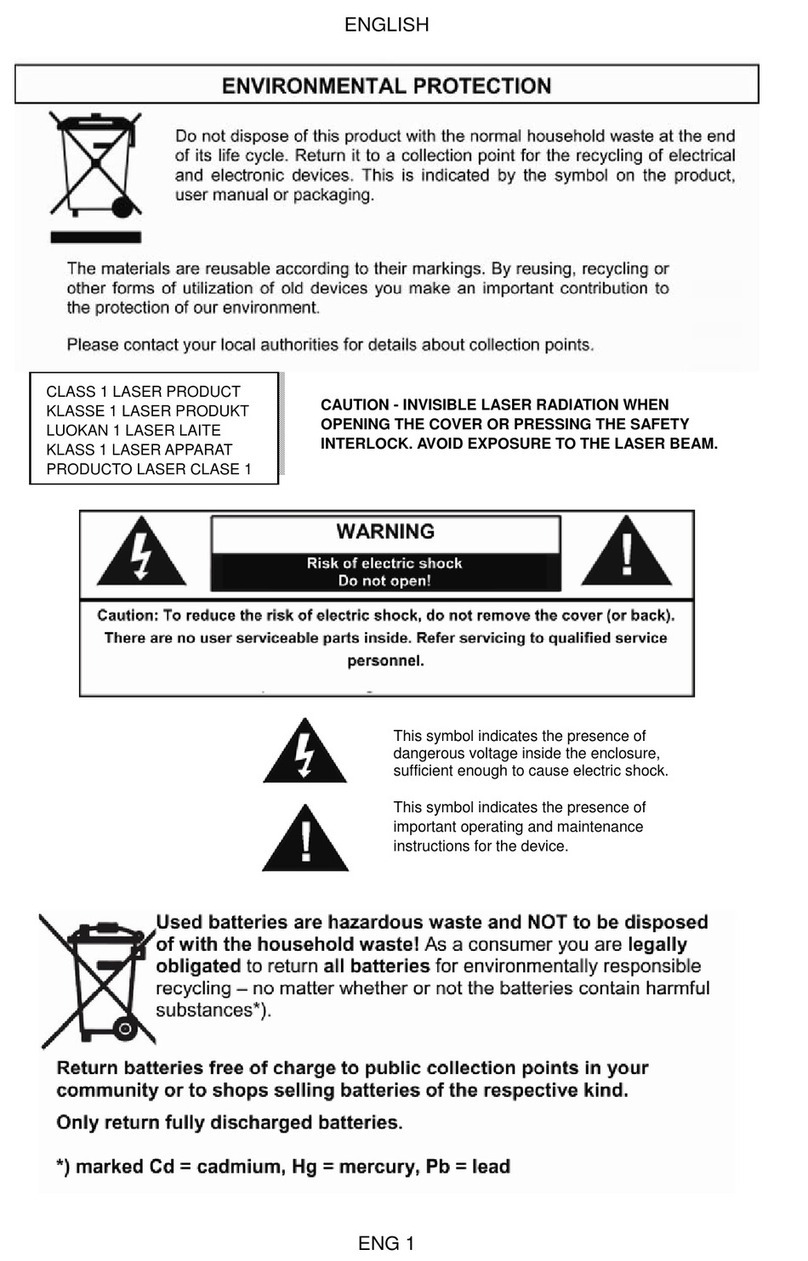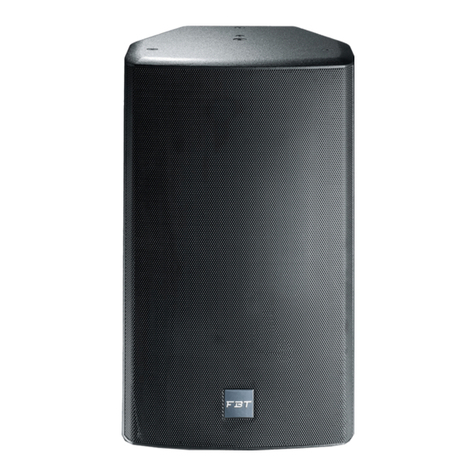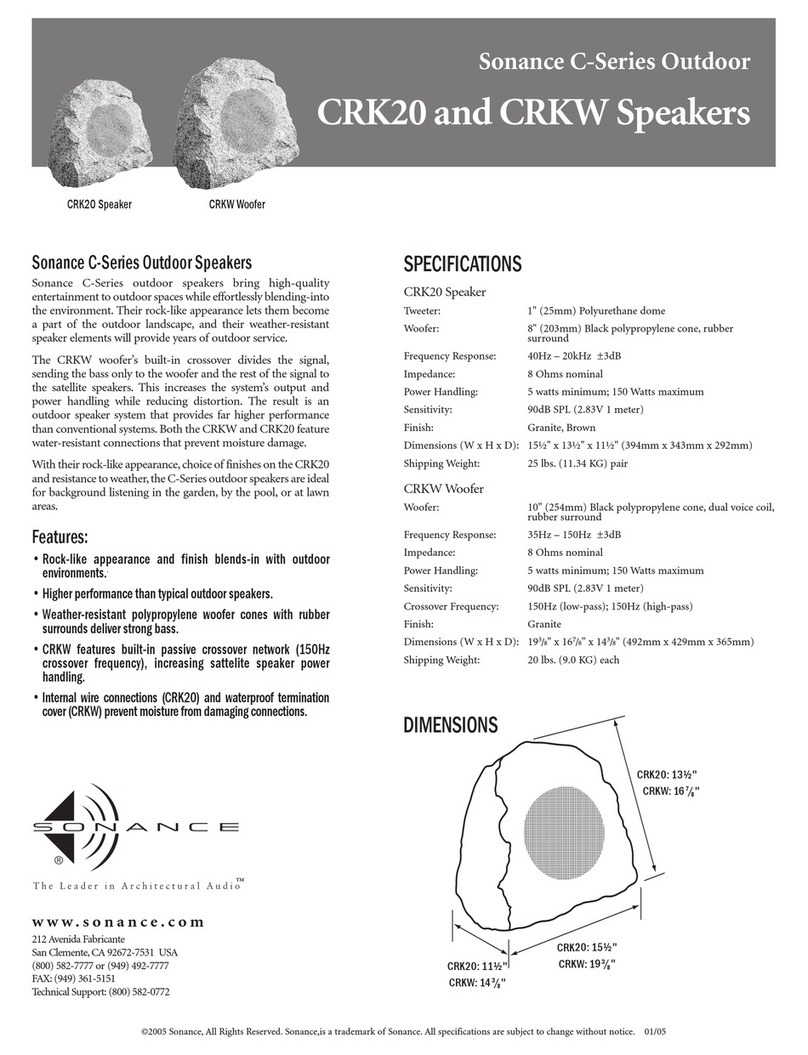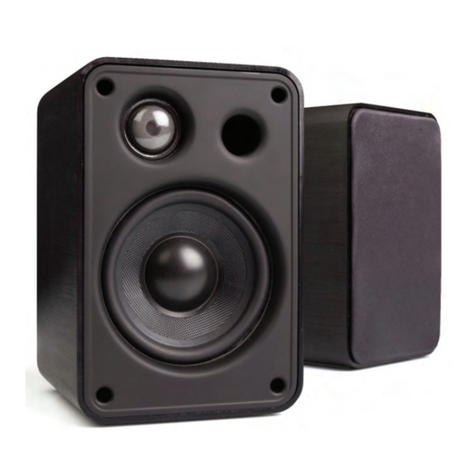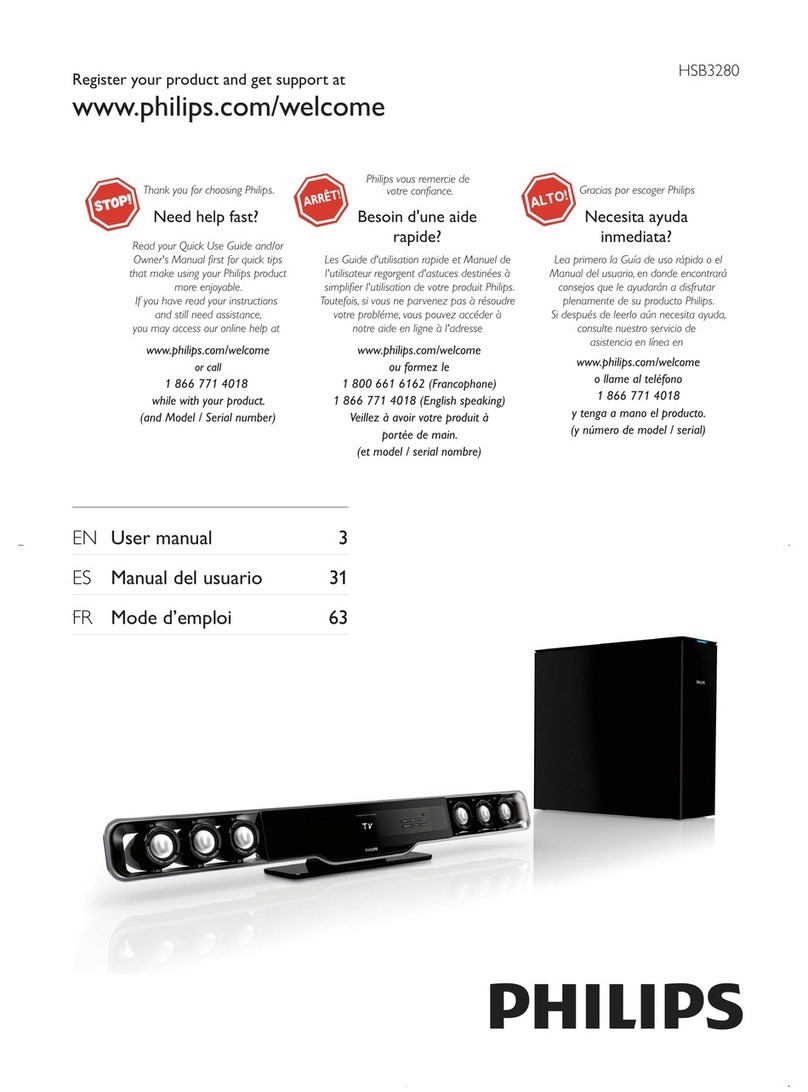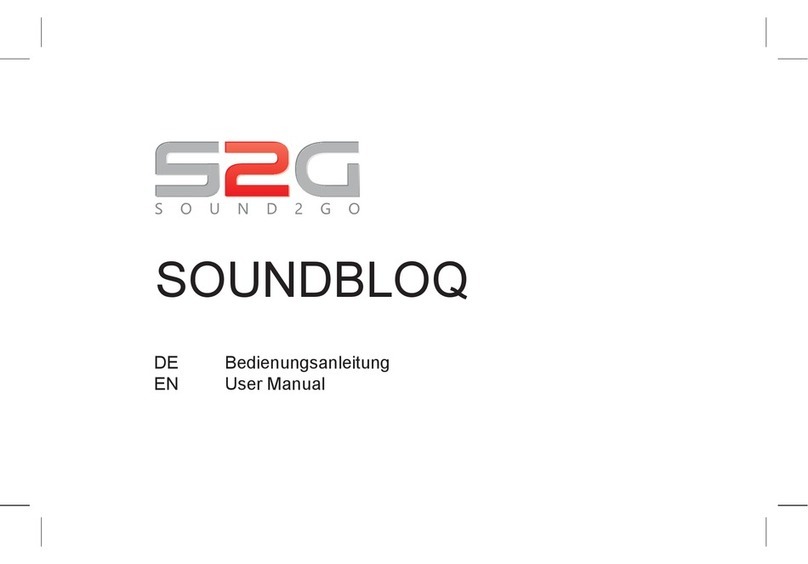Neumann.Berlin KH 310 A User manual

· . · ·
()/- · - · @. · ..
KH A
KH D
A S
O M


KH 310 | 1
Important safety instructions ...............................................2
The KH 310 studio monitor..................................................4
Package contents ..........................................................4
Product overview ..........................................................5
Installing and connecting the KH 310.........................................7
Preparing the loudspeakers ............................................7
Preparing the room....................................................8
Positioning the loudspeakers ...........................................8
Connecting audio signals..............................................11
Connecting/disconnecting the KH 310 to/from the mains power supply......14
Configuring and using the KH 310...........................................14
Switching the KH 310 on/o ...........................................14
Adjusting the frequency response ......................................14
Adjusting the acoustical level..........................................15
Compensating for video delay (lip sync) ................................16
Compensating for listening distance dierences (time-of-flight) ............16
Activating ground lift .................................................17
Adjusting the brightness of the Neumann logo ...........................18
Cleaning and maintaining the KH 310 .......................................18
Troubleshooting ..........................................................19
Specifications ............................................................19
Accessories ..............................................................21
Manufacturer Declarations .................................................22
Contents
Appendix
System Block Diagram .................................................I
Pin assignment of the XLR socket........................................I
Acoustical Measurements ..............................................I
Installation angles ....................................................V
Delay lookup table ...................................................VI
EN

2| KH 310
Important safety instructions
1. Read these instructions.
2. Keep these instructions. Always include these instructions when passing the product on to
third parties.
3. Heed all warnings.
4. Follow all instructions.
5. Do not use this apparatus near water.
6. Only clean the product when it is not connected to the mains power supply. Clean only with
a dry cloth.
7. Always ensure a free air flow around the cooling fins on the rear of the product. Do not
block any ventilation openings. Install in accordance with the manufacturer’s instruc-
tions.
8. Do not install near any heat sources such as radiators, heat registers, stoves, or other ap-
paratus (including amplifiers) that produce heat.
9. Do not defeat the safety purpose of the polarized or grounding-type plug. A polarized plug
has two blades with one wider than the other. A grounding type plug has two blades and a
third grounding prong. The wide blade or the third prong are provided for your safety. If
the provided plug does not fit into your outlet, consult an electrician for replacement of
the obsolete outlet.
10. Protect the power cord from being walked on or pinched, particularly at plugs, conveni-
ence receptacles, and the point where it exits from the apparatus.
11. Only use attachments/accessories specified by the manufacturer.
12. Use only with the cart, stand, tripod, bracket, or table specified by the manufactu-
rer, or sold with the apparatus. When a cart is used, use caution when moving
the cart/apparatus combination to avoid injury from tip-over.
13. Unplug this apparatus during lightning storms or when unused for long periods of time.
14. Refer all servicing to qualified service personnel. Servicing is required when the appara-
tus has been damaged in any way, such as power supply cord or plug is damaged, liquid
has been spilled or objects have fallen into the apparatus, when the apparatus has been
exposed to rain or moisture, does not operate normally, or has been dropped.
15. To completely disconnect this apparatus from the AC mains, disconnect the power supply
cord plug from the AC receptacle.
16. WARNING: To reduce the risk of fire or electric shock, do not expose this apparatus to rain
or moisture.
17. Do not expose this equipment to dripping or splashing and ensure that no objects filled
with liquids, such as vases, are placed on the equipment.
18. The mains plug of the power supply cord shall remain readily accessible.
• Ensure that the room in which you use this product is wired in accordance with the local
electrical code and checked by a qualified inspector.
• Only use the product indoors.
• Do not install the product in hot, humid, or excessively dusty locations, in direct sunlight or
in locations where it is exposed to externally generated vibrations.
• Do not place burning objects (e.g. candles) on top of or near the product.
• If condensation has formed on the product, e.g. because it was moved from a cold environ-
ment to a warm one, allow the product to acclimatize to room temperature before using it.
• Do not overload wall outlets and extension cables as this may result in fire and electric
shock.
Installation
EN

KH 310 | 3
WARNING
Danger of hearing damage due to sudden high sound pressure levels!
Audio signals that are present at switch-on of the product or that can be present during
operation, can create sudden, very high sound pressure levels which can damage your hea-
ring.
XAlways lower the output level of the audio source before connecting it to the loudspea-
ker, starting it (pressing “play”) or switching to a dierent source (analog/digital) via
the SIGNAL SELECT rotary switch G.
This loudspeaker can be used for commercial purposes. Commercial use is subject to the rules
and regulations of the trade association responsible. Neumann, as the manufacturer, is there-
fore obliged to expressly point out possible health risks arising from use. This loudspeaker is
capable of producing sound pressure levels exceeding 85 dB(A) SPL. This is the sound pres-
sure corresponding to the maximum permissible level which is by law (in some countries)
allowed to aect your hearing for the duration of a working day (8 hours). It is used as a basis
according to the specifications of industrial medicine.
Higher sound pressure levels and/or longer durations can damage your hearing. At higher
sound pressure levels, the duration must be shortened in order to prevent hearing damage.
The following are signs that you have been subjected to excessive sound pressure levels for
too long a time:
• You can hear ringing or whistling sounds in your ears.
• You have the impression (even for a short time only) that you can no longer hear high fre-
quencies (temporary threshold shift).
WARNING
Interference due to magnetic fields!
This product generates a permanent magnetic field (> 1.5 mT) that can interfere with car-
diac pacemakers and implanted defibrillators (ICDs).
XAlways maintain a distance of at least 10 cm (4") between the loudspeaker and the car-
diac pacemaker or implanted defibrillator.
The label shown on the right is attached to the rear of the
product.
The symbols on this label have the following meaning:
Presence of uninsulated dangerous voltage within the product’s enclo-
sure that may be of sucient magnitude to constitute a risk of fire or
electric shock.
Never open the product or remove the grilles fitted to the product as
there is a risk of electric shock. There are no user serviceable parts
inside. Refer servicing to your Neumann service partner.
Read and follow the safety and operating instructions contained in the
operating manual.
Intended use of the product includes:
• having read this operating manual, especially the chapter “Important safety instructions”,
• using the product within the operating conditions and limitations described in this opera-
ting manual.
“Improper use” means using the product other than as described in this operating manual, or
under operating conditions which dier from those described herein.
Danger due to
high sound
pressure levels
Magnetic fields
Hazard warnings
on the rear of
the product
Intended use EN

4| KH 310
The KH 310 studio monitor
Thank you for purchasing a Neumann studio monitor. The KH 310 features a Mathematically
Modeled Dispersion™ Waveguide (MMD™), flexible acoustical controls, various input options
and an extensive range of mounting hardware. This allows the loudspeaker to be used in
diverse acoustical conditions, with any source equipment and in a wide variety of physical
locations. The KH 310 represents the latest in acoustic and electronic simulation and measure-
ment technologies to ensure the most accurate sound reproduction possible.
Depending on the size, Neumann’s three-way loudspeaker systems are designed for use as
near-field monitors, as front loudspeakers in mid-sized multi-channel systems, or as rear
loudspeakers in larger multi-channel systems. They can be used in project, music, broadcast
centers, OB vans, and post production studios for tracking, mixing, and mastering.
Package contents
1 KH 310 A “left” or KH 310 A “right”
or
1 KH 310 D “left” or KH 310 D “right”
3 Mains cables (European, UK and US versions)
4 Self-adhesive feet
1 Operating manual
1 “Getting Started Quickly” supplement
Note that imperial dimensions are approximate.
The current operating manual as well as the supplement “Getting Started Quickly” can also be
downloaded from the “Downloads” area on the product page at www.neumann.com.
EN

KH 310 | 5
Product overview
The KH 310 comes in two variants named “left” and “right” (see figure). It is also possi-
ble to use a “left” in the “right” position, and vice versa. Both variants can also be used
as a center loudspeaker. Information about positioning your KH 310 can be found from
page 8.
2
1342
3
41
1Neumann logo
• lights up white:
loudspeaker is switched on and ready for operation
• flashes red:
loudspeaker’s protection system is active
output level is reduced
or
A digital signal is selected via the SIGNAL SELECT
rotary switch Gbut there is no valid digital signal
connected
• lights up red:
electronic‘s temperature is too high
output level is reduced by 20 dB
2Treble driver
3Midrange driver
4Bass driver
You can adjust the brightness of the Neumann logo. For more information, refer to
page18.
EN

6| KH 310
B
A
D
E
C
5
6
8
9
A
0
7
B
5ANALOG INPUT socket (XLR)
6GROUND switch
(Connects/disconnects ground)
7DISPLAY BRIGHTNESS switch
(Dims the Neumann logo)
8INPUT GAIN control
9OUTPUT LEVEL switch
0ACOUSTICAL CONTROLS switches
AThreaded inserts for Neumann mounting hard-
ware
BHandles with mounting holes
CCooling fins
DOn/o switch I/0
EIEC mains socket
B
A
D
E
C
ACOUSTICAL
CONTROLS [dB]
TREBLE
LOW-MIDBASS
OUTPUT
INPUT
SIGNAL SELECT
DELAY
-1.0
-2.0
+1.0
-1.5
-3.0
-4.5
-2.5
-7.5
-5.0
0
00
-15 0
-5
INPUT GAIN
AES 3
AES 3
OUTPUT LEVEL
[dB SPL at 1 m
for 0 dBu / -18 dB FS]
OFF
30
60
100
LIFT
CONNECT
x 1.6 ms
x 25.6 ms
x 0.1 ms
94
100
108
114
AES 3
INPUT
ANALOG
INPUT
Max. input
level 1.2 V pk-pk,
unbalanced
Sleeve: Shield
Tip: Signal
Max. input level 7 V pk-pk,
transformer balanced,
PIN 1 Shield, PIN 2 Signal +, PIN 3 Signal -
Max. input level 24 dBu, (*18 dBu for analog delayed),
electronically balanced,
Pin 1 Audio GND, Pin 2 Signal +, Pin 3 Signal -
Georg Neumann GmbH, Leipziger Str. 112, 10117 Berlin, Germany
DISPLAY
BRIGHTNESS [%]
GROUND
DIGITAL A+B
DIGITAL A+B
DIGITAL A
DIGITAL A
DIGITAL B
DIGITAL B
ANALOG
ANALOG*
DELAYED8
9
A
0
7
B
F
G
J
6
H
I
5
5ANALOG INPUT socket (XLR)
6GROUND switch
(Connects/disconnects ground)
7DISPLAY BRIGHTNESS switch
(Dims the Neumann logo)
8INPUT GAIN control
9OUTPUT LEVEL switch
0ACOUSTICAL CONTROLS switches
AThreaded inserts for Neumann mounting hard-
ware
BHandles with mounting holes
CCooling fins
DOn/o switch I/0
EIEC mains socket
FDELAY rotary switches
GSIGNAL SELECT rotary switch
HAES3 INPUT socket (BNC)
IAES3 OUTPUT socket (BNC)
JAES3 INPUT socket (XLR)
Back panel
KH 310 A
Back panel
KH 310 D
EN

KH 310 | 7
Installing and connecting the KH 310
CAUTION
Danger of injury and material damage due to tipping/dropping of the product!
If improperly mounted, the product and/or the mounting hardware (e.g. rack) can tip over
or drop down.
XAlways have the product mounted by a qualified specialist according to local, national
and international regulations and standards.
XUse the mounting systems recommended by Neumann and always provide sucient
additional protection against tipping or dropping!
CAUTION
Damage to the product due to overheating!
If air cannot circulate properly around the cooling fins on the rear of the product, the
amplifier(s) may overheat leading to premature activation of the thermal protection system
which limits the maximum output level of the loudspeaker. In rare cases, damage to the
product may also occur.
XNever cover the cooling fins.
XWhen installing the product into tight spaces such as wall recesses, maintain an air gap
of at least 5 cm (2") around the rear of the product and provide sucient air circulation.
If necessary, use forced-air cooling (e.g. in OB vans).
It is not possible to remove the electronics panel and locate it remotely.
For information on installation, please refer to the supplied “Getting Started Quickly”
supplement. This will help you set up the loudspeakers in a way that will give you the
best acoustic performance from the system.
For further information on setting up loudspeakers, please refer to the “Questions &
Answers” section on the product page at www.neumann.com.
For more information on building systems using Neumann loudspeaker products, please
refer to the “Product Selection Guide” at www.neumann.com
Preparing the loudspeakers
CAUTION
Risk of staining surfaces!
Some surfaces treated with varnish, polish or synthetics may suer from stains when they
come into contact with other synthetics. Despite a thorough testing of the synthetics used
by us, we cannot rule out the possibility of staining.
XDo not place the KH 310 on delicate surfaces.
CAUTION
Danger of damaging the midrange and bass drivers!
If the KH 310 is placed face down on a soft surface or if the front panel of the KH 310 is
pressed against your body when you carry it, the drivers can be damaged.
XNever place the KH 310 on a soft surface with the front panel facing downwards.
XAlways carry the KH 310 so that the front panel is facing upwards.
You can use the handles B on the rear panel to lift the loudspeaker.
EN

8| KH 310
To place the loudspeaker on a flat surface:
XAttach the supplied self-adhesive feet to the bottom of the cabinet.
This reduces the risk of scratching the surface and acoustically isolates the loudspeaker
from the surface.
Preparing the room
XArrange all acoustically relevant surfaces and objects symmetrically on either side of the
listening axis of the room (left/right).
XMinimize the sound that is reflected back to the listening position by using angled surfaces
and/or acoustical treatment.
This product has been optimized for use in recording studios. In order not to aect the
quality of reproduction, make sure that the product is used in an EMC environment.
Positioning the loudspeakers
XCarry out the following steps very accurately, since the more accurate the physical arrange-
ment of the loudspeakers in the room, the more accurate the reproduction will be at the lis-
tening position.
XObserve the recommended distances between the loudspeakers and your listening position
(imperial dimensions are approximate):
• Minimum: 0.75 m (2' 6")
• Recommended: 1.0–2.5 m (3'–8')
• Maximum: 6.0 m (18')
XAvoid positioning the loudspeaker at a distance “dwall” of 0.8 to 2 m (2' 6" to 6') from the wall
behind the loudspeaker.
When positioning bass managed loudspeakers:
XAvoid a distance “dwall” of 0.8 to 1 m (2' 6" to 3') from a solid wall behind the loudspeaker.
Similarly, avoid these distances from solid side walls or a solid ceiling. Respecting these
positioning limitations reduces the chances of dips and peaks in the low frequency response
(comb filtering) caused by strong reflections.
The KH 310 comes in two variants named “left” and “right”.
XPosition the two variants at the same height and so that the bass drivers are on the inside.
If you are building a multichannel system:
XUse either a “left” or “right” variant for the center loudspeaker. Line up the acoustical axis
along the center line of the loudspeaker array (see below).
Distances
Positioning the
KH 310
EN

KH 310 | 9
+30°-30°
+30°
-30° 0°
Front Left Front Center Front Right
XCopy the diagram “Installation angles” that can be found at the end of this operating manual.
XPlace the diagram at the listening position or center of the listening area.
XUsing a tape measure, place the loudspeakers at the same distance from the center of the dia-
gram “Installation angles”. To ensure good imaging, do this at an accuracy of at least 1cm
(1/2").
XMake sure that the distances are equal:
Length I
Front Left
Surround
Left
Surround
Right
Front Center Front Right
Length I
Length I
Length I
Length I
Listening
position
Arranging the
loudspeakers
EN

10 | KH 310
If the loudspeakers cannot be placed at the same distance from the listening position:
XCompensate for distance dierences > 1 cm (1/2") by delaying closer loudspeakers by 30 s/
cm (76 s/inch).
If you are using the KH 310 D:
XUse the DELAY rotary switches F to compensate for distance dierences (see
page16).
The DELAY rotary switches Fallow for corrections with a resolution of 3.44 cm
(13/8"), any small remaining time-of-flight adjustment should be made by moving
the loudspeaker cabinet.
KH 310 D
KH 310 D
KH 310 D
XCheck the location of the loudspeaker cabinet. This depends on the application:
• 2.0 systems (stereo): ±30°, plus optional subwoofer(s)
• 5.1 systems:
ITU-R BS.775-1: 0°, ±30°, ±110° (±10°), plus optional subwoofer(s)
(center, front left/right, surround left/right)
ANSI/SMPTE 202M: 0°, ±22.5°, arrays to the surround left and to the surround right,
plus optional subwoofer(s)
• 7.1 systems: 0°, ±30°, ±90°, ±150°, plus optional subwoofer(s)
(center, front left/right, side left/right, back left/right)
The acoustical axis of the KH 310 starts from the midpoint of the midrange and tweeter dri-
vers.
XAlways point the acoustical axis, in the horizontal and vertical planes, towards the listening
position.
The acoustical axis is a line perpendicular to the loudspeaker’s front panel along which
the microphone was placed when tuning the loudspeaker’s crossover during design.
Pointing the acoustical axis, in the horizontal and vertical planes, towards the listening
position or center of the monitoring area will give the best measured and perceived
sound quality.
XPosition the loudspeaker so that there is a direct line of sight from the listening position to
the bass, midrange and tweeter drivers.
x = 9.1 cm
y = 17.0 cm
EN

KH 310 | 11
Connecting audio signals
XAlways use good quality cables with the correct impedance and appropriate termination to
avoid signal drop outs and to achieve the maximum cable lengths shown below:
Signal (connector) Impedance Cable length Connection method
Analog (RCA) low up to 10 m
(30')
via an adapter (RCA-XLR)
to the ANALOG INPUT socket
(XLR) 5 (see below)
Analog (XLR) low up to 100 m
(300')
directly to the ANALOG INPUT
socket (XLR) 5 (see below)
AES3 (BNC) 75 Ω up to 100 m
(300')
directly to the AES3 INPUT
socket (BNC)H (see page 12)
AES3 (XLR) 110 Ω up to 100 m
(300')
directly to the AES3 INPUT
socket (XLR)J (see page 12)
S/P-DIF (RCA) 75 Ω up to 10 m
(30')
via an adapter (RCA-BNC) to the
AES3 INPUT socket (BNC)H (see
page 12) or via an adapter
(RCA-XLR) to the AES3 INPUT
socket (XLR)J (see page 12)
Connecting analog signals to the KH 310 A and the KH 310 D
XOnly connect analog signals to the KH 310 A.
XConnect the left and right output of your analog audio source to the XLR input sockets of
the respective loudspeaker.
XLR XLR
Signal B
Signal A
Analog Source
XUse an RCA-XLR adapter (not supplied) to connect unbalanced cables (e.g. RCA cables).
XUse the following wiring if you want to make your own RCA-XLR adapter:
Wiring Pin Signal
Unbalanced RCA to balanced XLR connections
1Audio ground
2Signal +
3Signal −
If there is a humming sound from the loudspeaker, activate ground lift to disconnect
pin 1 of the ANALOG INPUT socket (XLR)5from the loudspeaker’s chassis ground.
Connecting
XLRcables
Connecting
unbalanced cables
EN

12 | KH 310
Connecting digital signals to the KH 310 D
XConnect the digital AES3 or S/P-DIF-output signal of your audio source to the AES3
INPUT socket Hor Jof the respective KH 310 D. See figure below.
The KH 310 D loudspeaker only supports non-encoded AES3 and S/P-DIF signals.
Encoded signals such as MP3, DTS or Dolby Digital are not supported.
XMake an appropriate setting (“DIGITAL A” or “DIGITAL B”) on the SIGNAL SELECT
rotary switch G. The setting depends on the signal channel order and the loudspeaker
position.
Only one cable is needed for uncompressed AES3 and S/P-DIF digital signals
(single-wire mode). They contain two audio channels: “subframe A” and “sub-
frame B”. Usually, the audio channels are:
Subframe A Subframe B
Left Right
Center LFE
Surround left Surround right
Back left Back right
A clock input is not required because loudspeakers are not audio sources and the
converters are clocked to a very stable internally generated clock source.
To connect an additional loudspeaker:
XUse the AES3 OUTPUT socket I. See figure below.
XMake an appropriate setting (“DIGITAL A” or “DIGITAL B”) on the SIGNAL SELECT
rotary switch G.
XLR
or
BNC
In
BNC
Out
Subframe A - left signal
Subframe B - right signal
Digital Source:
AES 3 or S/P-DIF
BNC
In
RCA, BNC or XLR
Set back panel switch to “DIGITAL A” Set back panel switch to “DIGITAL B”
KH 310 D
KH 310 D
KH 310 D
Connecting
AES3 cables
EN

KH 310 | 13
Connecting multiple KH 310 D loudspeakers together
XUse the AES3 INPUT Hand OUTPUT socket (BNC) I. T-pieces are not required (see
figure below).
XMake an appropriate setting (“DIGITAL A” or “DIGITAL B”) on the SIGNAL SELECT
rotary switch G.
End of the line external termination is not required as the AES3 INPUT socket (BNC) H
already has an internal 75 Ω termination.
XLR
or
BNC
In
BNC
Out
Subframe A - left signal
Subframe B - right signal
Digital Source:
AES 3 or S/P-DIF
BNC
In
BNC
Out
BNC
In
BNC
Out
BNC
In
RCA, BNC or XLR
Set back panel switch to “DIGITAL A” Set back panel switch to “DIGITAL B”
Setting the SIGNAL SELECT rotary switch G
XSelect one of the following settings, depending on your needs:
Setting Meaning
ANALOG XLR input socket 5
DIGITAL A Digital subframe A, AES3 INPUT socket (BNC) Hor
AES3 INPUT socket (XLR)J
DIGITAL B Digital subframe B, AES3 INPUT socket (BNC) Hor
AES3 INPUT socket (XLR)J
DIGITAL A+B Digital subframe A summed with digital subframe B
and a 6 dB attenuation, AES3 INPUT socket (BNC) Hor
AES3 INPUT socket (XLR)J
Each of these can be selected with and without delay added, so it is very quick to bypass
the delay.
The digital output is a buered copy of the digital input signal which can be used to feed
the digital signal onto other loudspeaker or products. There is no digital output from the
AES3 OUTPUT socket (BNC) Iwhen an analog signal is connected to the ANALOG INPUT
socket 5, therefore the KH 310 D cannot be used as an analog-to-digital converter.
KH 310 D
KH 310 D
KH 310 D
EN

14 | KH 310
Connecting/disconnecting the KH 310 to/from the mains
power supply
To connect the KH 310 to the mains power supply:
XMake sure that the on/o switchD is set to “0”.
XConnect the IEC connector of the supplied mains cable to the mains socket E.
D
E
Power Source
XConnect the mains plug of the mains cable to a suitable wall socket.
To disconnect the KH 310 from the mains power supply:
XSet the on/o switch Dto “0”.
XPull the mains plug out of the wall socket.
Configuring and using the KH 310
Switching the KH 310 on/o
XSet the on/o switch to:
• “I” to switch on the loudspeaker. The Neumann logo lights up, provided that it has not
been switched o by means of the DISPLAY BRIGHTNESS switch 7(see page 18).
• “0” to switch o the loudspeaker. The Neumann logo goes o.
There is an approximate five second delay before sound can be heard from the loud-
speaker in order to avoid noises (pops) from preceding equipment switched on at the
same time. Conversely, switching o the loudspeaker immediately mutes the audio.
Adjusting the frequency response
When all its acoustical controls are set to 0 dB, the KH 310 loudspeaker is designed to have
a flat frequency response in anechoic conditions. When the loudspeaker is installed in your
monitoring environment, the response changes.
EN

KH 310 | 15
The same loudspeaker installed in dierent positions in the same room may require dierent
acoustical control settings. In a symmetrical installation, left/right pairs (front or back) will
probably have the same acoustical control settings.
XBefore using your loudspeaker system for the first time, calibrate the frequency response of
the loudspeakers in the room in order to obtain the desired response.
XRepeat the above step if you change the physical conditions in your studio.
XAt your listening position, determine the frequency response of each loudspeaker.
XUse the ACOUSTICAL CONTROLS switches 0to adjust the frequency response.
Recommended frequency responses measured at the listening position:
• Studio applications: flat
• Film applications: X-curve shape (see ANSI/SMPTE 202M)
• Home applications: subjective evaluation
ACOUSTICAL CONTROLS
switches 0
Function Possible settings
Bass Compensates for acoustical
loading in the low frequency
range due to nearby large solid
boundaries (e.g. walls).
0, −2.5, −5, −7.5 dB
Low-Mid Compensates for acoustical
loading in the low-mid frequency
range due to nearby large solid
objects (e.g. mixing consoles,
desks or flat screens).
0, −1.5, −3, −4.5 dB
Treble Compensates for insucient or
excessive high-frequency
damping in the room.
+1, 0, −1, −2 dB
The following settings can be used as a starting point for further adjustment:
Loudspeaker position ACOUSTICAL CONTROLS
switches 0
Bass Low-Mid Treble
In a corner −7.5 dB −1.5 dB –
Next to an acoustically solid wall (e.g. brick, concrete) −5 dB – –
Next to an acoustically soft wall (e.g. gypsum) −2.5 dB – –
Free standing in an untreated room −2.5 dB –−1 dB
Free standing in a well-treated room – – –
In a small room with strong side wall reflections −5 dB 0 dB –
Near a small desktop or small reflecting surface* –−1.5 dB –
Near a large desktop or large reflecting surface* –−3 dB –
* Use these settings in addition to one of the top settings
Adjusting the acoustical level
XOn your KH 310 loudspeakers, set the OUTPUT LEVEL switch 9to 94 dB SPL and the INPUT
GAIN control 8to −15 dB.
XPlay a broadband pink noise test signal that is set to −18 dBFS (Europe) or −20 dBFS (USA)
on the mixing console‘s output level meters.
XMeasure the sound pressure level at the listening position using a sound level meter with
the following settings:
• “C”-weighted
• slow integration time
EN

16 | KH 310
XSet the OUTPUT LEVEL switch 9 and the INPUT GAIN control 8of your loudspeakers so
that the desired acoustic level is obtained.
Recommended sound pressure levels:
Application Sound pressure level
Film 85 dB(C)
Broadcast 79 to 83 dB(C)
Music No defined reference levels
If the Neumann logo flashes red, the loudspeaker‘s protection system has been activated.
To avoid this and achieve the desired output level, use larger loudspeakers or add a bass
managed subwoofer to the system.
Examples of sound pressure levels as a function of the input and output level of the KH 310:
Input signal
[dBu]
0
(0.775 V)
0
(0.775 V)
+4
(1.23 V)
−20
(77.5 mV)
INPUT GAIN control 8
[dB] 0−15 −4 −15
OUTPUT LEVEL switch 9
[dB SPL] 100 100 94 114
Sound pressure level
[dB SPL] at 1 m
100 85 94 79
Compensating for video delay (lip sync)
Signal processing in LCD, Plasma and LED screens, digital projectors with LCD or DLP
chips, and video processors used in broadcast centers delays the video signal.
The delay is disturbing when audio leads video by more than 20 ms or lags by more than
40 ms.
To compensate for the video signal delay, the audio signal can be delayed by up to
409.5ms, which is 10.2 frames at 40 ms/frame or 12.3 frames at 33 ms/frame. The same
value should be used for all loudspeakers in the system.
Please consider the information on latency on page 17.
Compensating for listening distance dierences (time-
of-flight)
Loudspeakers placed at dierent distances suer from time-of-flight dierences which
aects imaging. The delay resolution is small enough (0.1 ms) that the delay can be used
for time-of-flight adjustment (3.44 cm or 1 3/8" steps).
To compensate for the time-of-flight delay, the audio signal of the KH 310 D can be
delayed by up to 409.5 ms, which is 140.87m (462'2"). Loudspeakers positioned closer
to the listening position should be delayed to be the same as the furthest loudspeaker
from the listening distance.
KH 310 D
KH 310 D
KH 310 D
DELAY
x 1.6 ms
x 25.6 ms
x 0.1 ms
SIGNAL SELECT
DIGITAL A+B
DIGITAL A+B
DIGITAL A
DIGITAL A
DIGITAL B
DIGITAL B
ANALOG
ANALOG*
DELAYED
EN

KH 310 | 17
Example
Loudspeaker A listening distance: 1.50 m
Loudspeaker B listening distance: 1.65 m
Time-of-flight dierence: 0.15 m
So loudspeaker A should be delayed by the time equivalent of 0.15 m which is 0.436 ms
(0.15 m / 3.44 cm x 0.1 ms). The nearest setting of the DELAY rotary switches Fis 0.4
ms, so set the 0.1 ms switch to position 4.
Please consider the information on latency further down.
If a video delay compensation has already been made, add the time-of-flight dierence
(here: 0.4 ms) to the setting already made.
Example
Video delay compensation on loudspeaker A: 2 x 40 ms/frame
Desired time-of flight compensation for loudspeaker A: 0.4 ms
Time-of-flight compensation: 80.4 ms
This delay value can be made with these switch settings: 3 x 25.6 ms, 2 x 1.6 ms, 4 x 0.1 ms.
The latency of the analog-to-digital and digital-to-analog converters should be
taken into account when using the DELAY rotary switches Ffor time-of-flight com-
pensation. For the digital-to-analog conversion (input signal via digital connector),
the latency is dependent on the sample rate (values can be seen in the Specifica-
tions table on page 20). The analog-to-digital-to-analog conversion (input sig-
nal via analog connector) is fixed at 0.54 ms.
For time-of-flight compensation delay, calculate the desired delay value then sub-
tract the appropriate latency depending on the input signal and sample rate, and
then set the needed additional delay using the delay switches on the back panel.
Example:
Distance compensation for 1 m: 1 m / 344 m/s = 2,91 ms: 2.91ms
Digital input signal, sample rate: 48 kHz, latency: 0.85 ms
2.06 ms
Delay settings:
0 x 25.6 ms, 1 x 1.6 ms, 5 x 0.1 ms
(equals 2.1 ms, which is the nearest value)
For video delay compensation, converter latency can be ignored as it is insignifi-
cant compared to long video signal delays.
To help with choosing a delay setting there is a set of lookup tables at the end of
this operating manual. Also Neumann has made a delay calculator which is availa-
ble at www.neumann.com.
KH 310 D
KH 310 D
KH 310 D
Activating ground lift
If there is humming or buzzing noise coming from the loudspeaker, first search for the cause of
the noise:
XDisconnect all input and output signal cables from the loudspeaker.
If the noise goes away, it is probably coming from the audio source or source cabling.
EN

18 | KH 310
It might be possible to eliminate the noise by disconnecting the ground from the input signals (activating ground
lift).
To activate ground lift:
XReconnect the signal cables and set the GROUND switch 6to “LIFT”.
This internally disconnects pin 1 of the ANALOG INPUT socket (XLR)5from the loudspeaker’s chassis ground (see
diagram “Pin assignment of the XLR socket” on page 11).
For safety reasons, the electronics chassis ground is always connected to the mains
power earth pin.
Adjusting the brightness of the Neumann logo
WARNING
Danger of hearing damage due to unexpected high sound pressure levels!
If the Neumann logo is switched o, it is not obvious whether the product is switched on or o. In this case,
unexpected high sound pressure levels can cause hearing damage.
XAlways set the audio sources connected to the loudspeaker to a low output level before they deliver an audio
signal.
XIf you switch o or dim the Neumann logo, mention this to everyone who works with this loudspeaker or the
connected audio sources.
To dim or switch o the Neumann logo in low light level environments or when the loudspeaker is placed behind an
acoustically transparent screen:
XSet the DISPLAY BRIGHTNESS switch 7to:
• “30 %”, “60 %” or “100 %” to adjust the Neumann logo to dierent brightness levels.
• “OFF” to switch o the Neumann logo.
When the loudspeaker’s protection system is active or invalid digital signals are connected to the KH 310 D,
the color of the Neumann logo changes from white to red. The brightness of this red limiter indication corres-
ponds to the setting of the DISPLAY BRIGHTNESS switch 7(“30 %”, “60%” or “100 %”). However, you cannot
completely switch o the limiter indication, as it appears with a brightness of 30 % even if the DISPLAY
BRIGHTNESS switch 7is set to “OFF”.
Cleaning and maintaining the KH 310
CAUTION
Damage to the product caused by liquids!
Liquids entering the product can cause a short-circuit in the electronics and damage or even destroy the product.
XKeep all liquids away from the product!
XBefore cleaning, disconnect the product from the mains power supply.
XUse a soft, dry, and lint-free cloth to clean the product. Do not use any solvents or cleaning agents.
XClean the cooling fins regularly. They should always be kept free from dust.
XNever touch the driver diaphrams.
EN
This manual suits for next models
1
Table of contents
Other Neumann.Berlin Speakers manuals

Neumann.Berlin
Neumann.Berlin KH 120 A User manual
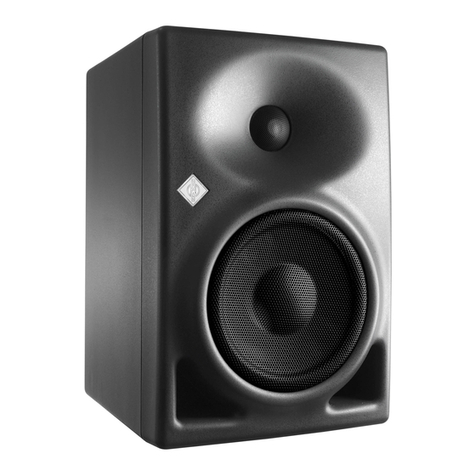
Neumann.Berlin
Neumann.Berlin KH 120 D User manual
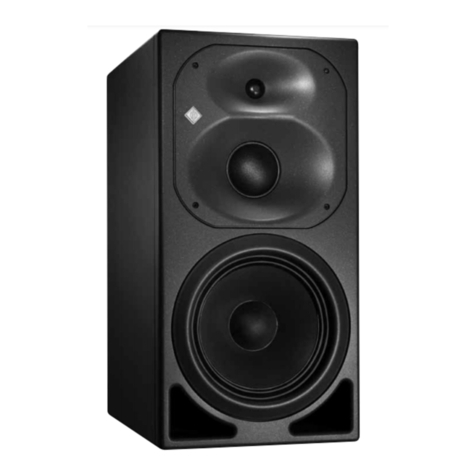
Neumann.Berlin
Neumann.Berlin KH 420 User manual
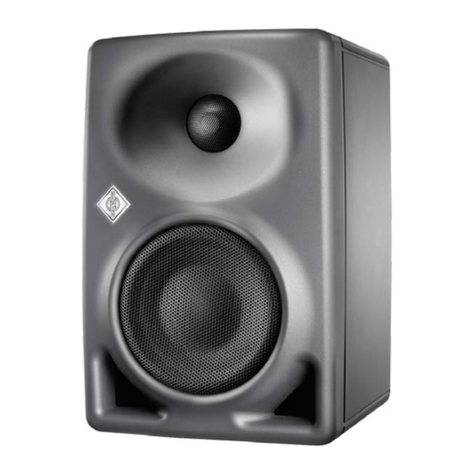
Neumann.Berlin
Neumann.Berlin KH 80 DSP User manual
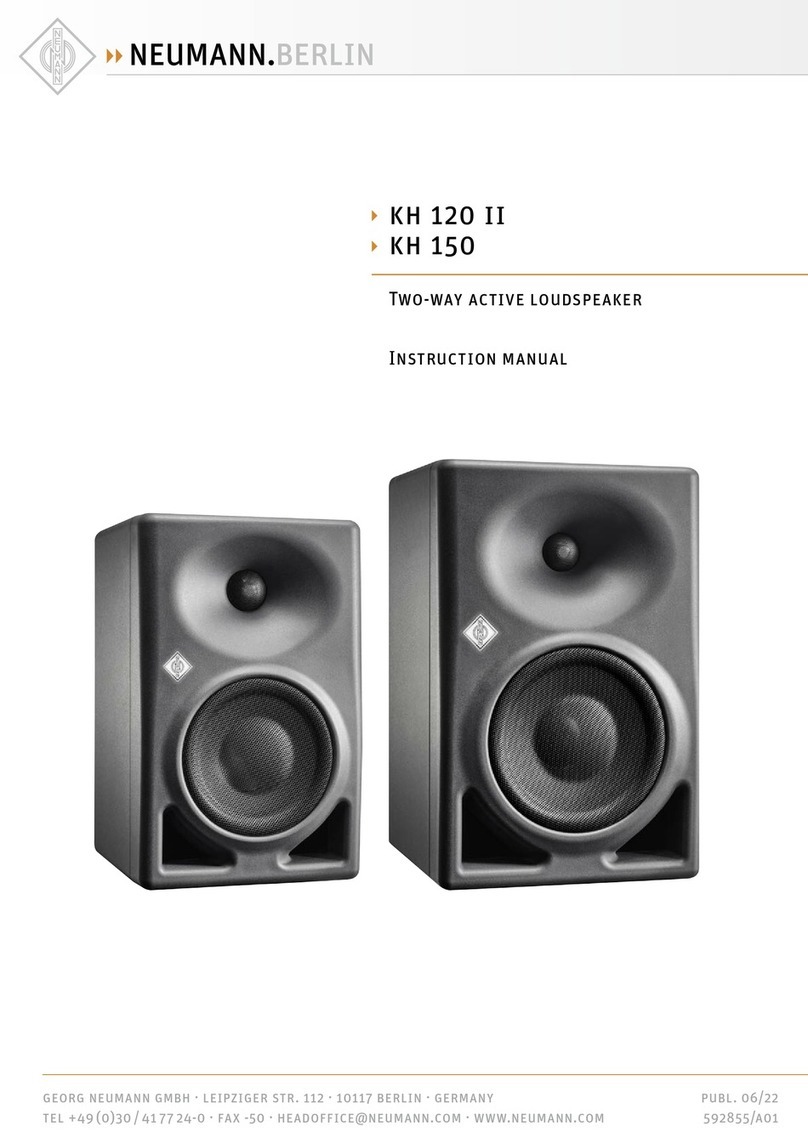
Neumann.Berlin
Neumann.Berlin KH 120 II User manual

Neumann.Berlin
Neumann.Berlin KH 80 DSP User manual
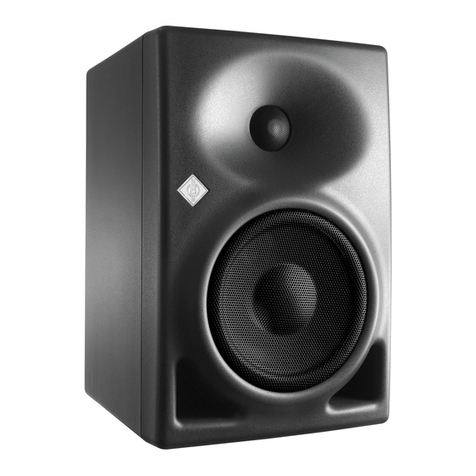
Neumann.Berlin
Neumann.Berlin KH 120 A User manual

Neumann.Berlin
Neumann.Berlin KH 80 DSP User manual
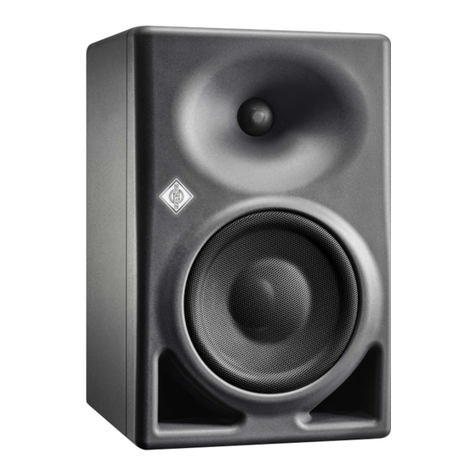
Neumann.Berlin
Neumann.Berlin KH 150 AES67 User manual
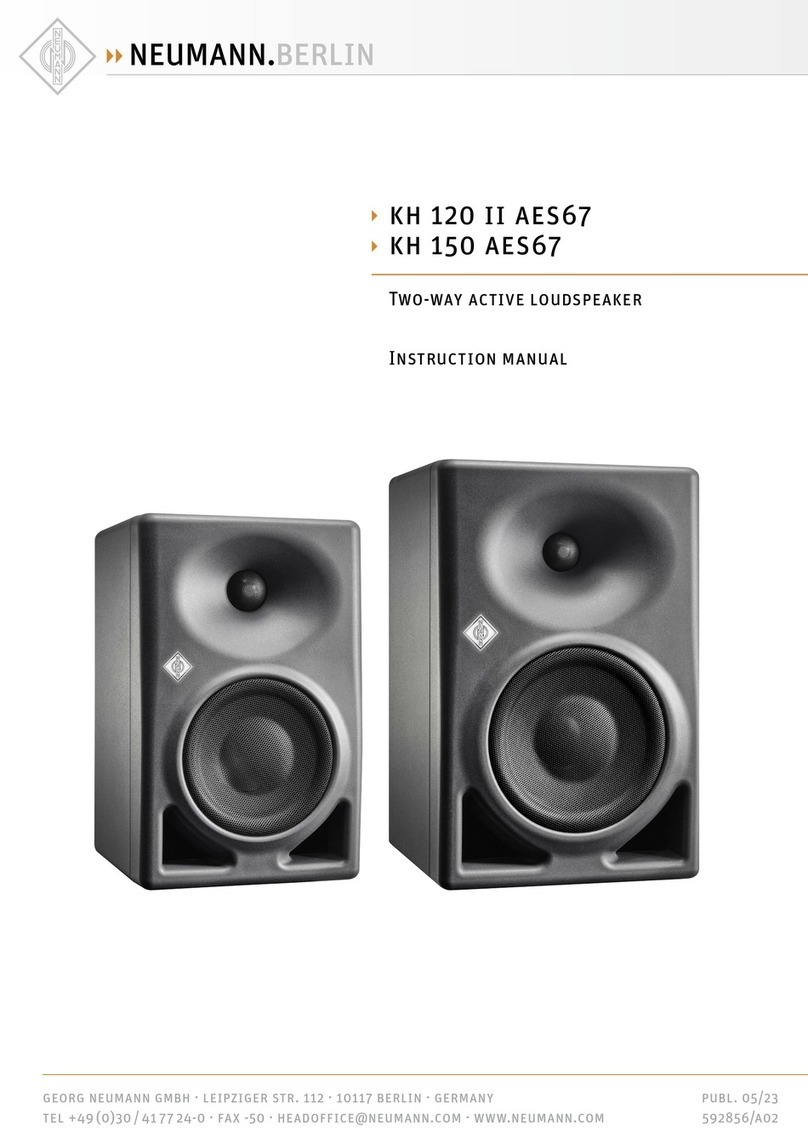
Neumann.Berlin
Neumann.Berlin KH 120 II AES67 User manual
